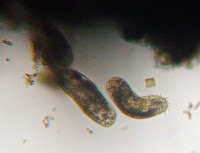In going back to my MicroAquarium this week the first change I noticed was the water level. It has decreased close to or a little less than a cm over the past week. I assume this is due to plants A and B using the water to grow and develope. While looking at Plant A, I noticed some of it is now out of the water resulting in that piece of the plant being darker and having smaller leaves than the rest of the plant. This is all I noticed about plant A because there were no organisms apparent around or on it.
Plant B had a few new things about it. It is growing a lot of hair-like structures out in all directions. There were many different kinds of multicellular organisms hiding in these structures. One I noticed was very transparent and had a long, flat shape, and it continuously circled the structure. Another was less translucent and moved repetatively in a circle within the plant.
In the sediment it was hard to see organisms moving but I was able to find a few very small multicellular organisms that appeared to be feeding off the nutrients in the soil. I caught a glimpse of a worm-like organism who came out but quickly rehid itself in the sediment. More interestingly in some algae that had fallen to the bottom of the MicroAquarium, there was an organism attached to it whose movements were intriguing. It was attached to the algae and moved back and forth while still attached to the one fixed point on plant, and while doing this, appeared to be stretching itself outward.
Lastly, in the water, there was a large multicellular organism that had a rounded body and a small pointed tail on the end. The organism was very active using its tail to change directions and propel itself. It maneuvered its way to the dirt where it appeared to be eating. When it reappeared from the dirt, I could see a sligt color difference then, but almost immediately, it went back into the soil.

 and function around the aquarium.
and function around the aquarium. and function around the aquarium.
and function around the aquarium.

